第七版曼昆经济学原理宏观第3章
曼昆经济学原理第七版第三章
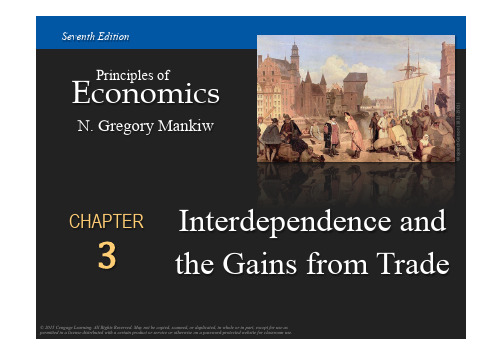
© 2015 Cengage Learning. All Rights Reserved. May not be copied, scanned, or duplicated, in whole or in part, except for use as permitted in a license distributed with a certain product or service or otherwise on a password-protected website for classroom use.
9
© 2015 Cengage Learning. All Rights Reserved. May not be copied, scanned, or duplicated, in whole or in part, except for use as permitted in a license distributed with a certain product or service or otherwise on a password-protected website for classroom use.
Wheat (tons) 5,000 4,000 3,000 2,000 1,000 0
The U.S. Without Trade
Suppose the U.S. uses half its labor to produce each of the two goods. Then it will produce and consume 250 computers and 2500 tons of wheat.
© 2015 Cengage Learning. All Rights Reserved. May not be copied, scanned, or duplicated, in whole or in part, except for use as permitted in a license distributed with a certain product or service or otherwise on a password-protected website for classroom use.
曼昆宏观经济学第七版中文答案

曼昆宏观经济学第七版中文答案【篇一:曼昆宏观经济学-课后答案第6、7版】txt>复习题1、由于整个经济的事件产生于许多家庭与许多企业的相互作用,所以微观经济学和宏观经济学必然是相互关联的。
当我们研究整个经济时,我们必须考虑个别经济行为者的决策。
由于总量只是描述许多个别决策的变量的总和,所以宏观经济理论必然依靠微观经济基础。
2、经济学家是用模型来解释世界,但一个经济学家的模型往往是由符号和方程式构成。
经济学家建立模型有助于解释gdp、通货膨胀和失业这类经济变量。
这些模型之所以有用是因为它们有助于我们略去无关的细节而更加明确地集中于重要的联系上。
模型有两种变量:内生变量和外生变量,一个模型的目的是说明外生变量如何影响内生变量。
3、经济学家通常假设,一种物品或劳务的价格迅速变动使得供给量与需求量平衡,即市场走向供求均衡。
这种假设称为市场出清。
在回答大多数问题时,经济学家用市场出清模型。
持续市场出清的假设并不完全现实。
市场要持续出清,价格就必须对供求变动作出迅速调整。
但是,实际上许多工资和价格调整缓慢。
虽然市场出清模型假设所有工资和价格都是有伸缩性的,但在现实世界中一些工资和价格是粘性的。
明显的价格粘性并不一定使市场出清模型无用。
首先偷格并不总是呆滞的,最终价格要根据供求的变动而调整。
市场出清模型并不能描述每一种情况下的经济,但描述了经济缓慢地趋近了均衡。
价格的伸缩性对研究我们在几十年中所观察到的实际gdp增长这类长期问题是一个好的假设。
第二章宏观经济学数据"复习题1、gdp既衡量经济中所有人的收入,又衡量对经济物品与劳务的总支出。
gdp能同时衡量这两件事,是因为这两个量实际上是相同的:对整个经济来说,收入必定等于支出。
这个事实又来自于一个更有基本的事实:由于每一次交易都有一个买者和一个卖者,所以,一个买者支出的每一美元必然成为一个卖者的一美元收入。
2、cpi衡量经济中物价总水平。
它表示相对于某个基年一篮子物品与劳务价格的同样一篮子物品与劳务的现期价格。
中级宏观经济学曼昆英文版第七版第三章习题答案重点

中级宏观经济学曼昆英文版第七版第三章习题答案重点11Chapter 3 National Income: Where It Comes From and Where It Goes 21 If consumption depends on the interest rate, then these conclusions about fiscal policy are modified somewhat. If consumption depends on the interest rate, then so does saving. The higher the interest rate, the greater the return to saving. Hence, it seems reasonable to think that an increase in the interest rate might increase saving and reduce consumption.Figure 3–6 shows saving as an increasing function of the interest rate. r S(r Figure 3–6 Real interest rate S Saving Consider what happens when government purchases increase. At any given level of the interest rate, national saving falls by the change in government purchases, as shown in Figure 3–7. The figure shows that if the saving function slopes upward, investment falls by less than the amount that government purchases rises by; this happens because consumption falls and saving increases in response to the higher interest rate. Hence, the more responsive consumption is to the interest rate, the less government purchases crowd out investment. r S2(r S1(r Figure 3–7 Real interest rate r1 r ?G I(r I1 II, S Investment, Saving 13. a. Figure 3–8 shows the case where the demand for loanable funds is stable but the supply of funds (the saving schedule fluctuates perhaps reflecting temporary shocks to income, changes in government spending, or changes in consumer confidence. In this case, when interest rates fall, investment rises; when interest rates rise, investment falls. We would expect a negative correlation between investment and interest rates.22 Answers to Textbook Questions and Problems S1 (r r S2 (r Figure 3–8 Real interest rate I(r I, S Investment, Saving b. Figure 3-9 shows the case where the supply of loanable funds (saving does not respond to the interest rate. Also suppose that this curve is stable, whereas the demand for loanable funds varies, perhaps reflecting fluctuations in firms’ expectations about the marginal product of capital. We would now fin d a positive correlation between investment and the interest rate—when demand for funds rises, this pushes up the interest rate, so we see investment increase and the real interest rate increase at thesame time. r S(r Figure 3–9 Real interest rate I 2 (r I 1 (r I, S Investment, SavingChapter 3 National Income: Where It Comes From and Where It Goes 23 c. If both curves shift, we might generate a scatter plot as in Figure 3–10, where the economy fluctuates among points A, B, C, and D. Depending on how often the economy is at each of these points, we might find little clear relationship between investment and interest rates. r S1 (r S2 (r D Real interest rate C A Figure 3–10 B I 1 (r I 2 (r I, S Investment, Saving d. Situation (c seems fairly reasonable—both the supply of and demand for loanable funds fluctuate over time in response to changes in the economy.。
中文曼昆宏观经济学第七版讲义
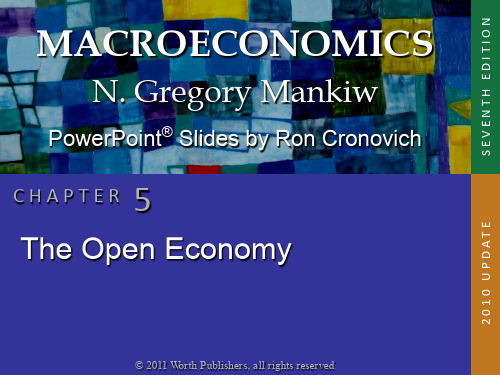
13
Assumptions about capital flows
a. domestic & foreign bonds are perfect substitutes (same risk, maturity, etc.)
b. perfect capital mobility: no restrictions on international trade in assets
I (r* )
S, I
CHAPTER 5 The Open Economy
15
If the economy were closed…
r
…the interest rate would adjust to equate investment
and saving: rc
S
I (r )
CHAPTER 5 The Open Economy
I (rc ) S
S, I
16
But in a small open economy…
r
the exogenous
world interest
rate determines
investment…
r*
…and the
difference
rc
between saving
and investment
determines net
5
The national income identity in an open economy
Y = C + I + G + NX
or, NX = Y – (C + I + G )
net exports
曼昆《宏观经济学》(第七版)考研笔记 - 2
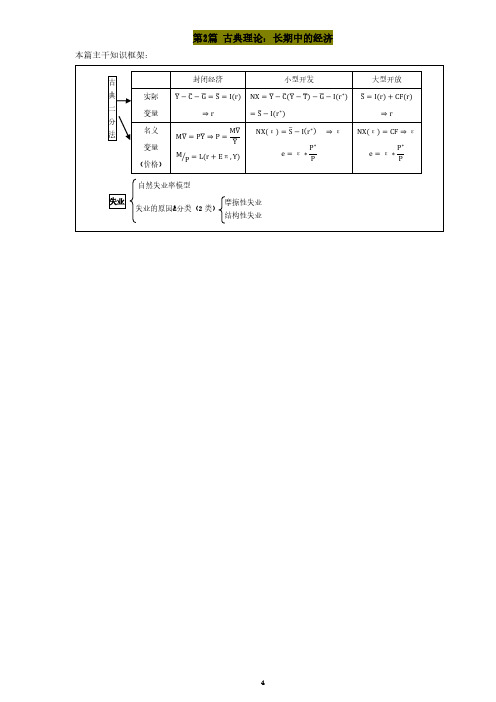
第2篇古典理论:长期中的经济本篇主干知识框架:第3章 国民收入:源自何处,去向何方(一般均衡模型)本章分析的出发点(教材图3-1)本章主干知识框架:3.1 什么决定了产品与服务的总生产(略) 3.2 国民收入如何分配给生产要素:新古典分配理论②对任何一种生产要素支付的价格都取决于该要素服务的供给和需求。
由于已假设供给是固定的,所以供给曲线是一条垂直线。
需求曲线向下倾斜。
两曲线的交点决定了均衡的要素价格。
为了理解要素价格和收入分配,必须考察生产要素的需求,为此我们从研究一个典型企业使用多少生产要素的决策问题开始。
②新古典分配理论,neoclassical theory of distribution.3.2.1 企业如何决策→要素需求→要素价格(一)竞争性企业面临的决策:利润=PF (K,L )−WL −RK假设企业是竞争性的,将产出和投入的价格都视为由市场条件决定(价格接受者)。
(二)MPL ↓⇒劳动需求曲线大多数生产函数具有边际产量递减的性质:在资本量不变的情况下,随着劳动量的增加,劳动边际产量递减。
企业多雇佣一单位劳动的利润变化是: ∆利润=P x MPL-W 。
竞争性企业对劳动的需求由下式决定:P x MPL=W 或者MPL=W/P (实际工资)为了使利润最大化,企业雇佣劳动,直到劳动的边际产量等于实际工资这一点为止。
由于MPL 随着L 增加而递减,故MPL 曲线向下倾斜。
企业雇用工人知道司机工资等于MPL 位置。
因此,MPL 曲线也就是企业的劳动需求曲线。
(三)资本MPK(↓)与资本需求:MPK=R/P (实际租赁价格) (四)总结:总之,竞争性的追求利润最大化的企业关于要素使用的决策都遵循着一个简单规划:企业需要每一种生产要素,直到该要素的边际产量减少到等于其实际要素价值为止。
3.2.2 国民收入的划分经济利润=Y −MPL ∗L −MPK ∗K 或,Y =MPL ∗L +MPK ∗K +经济利润经济利润有多少呢? 若生产函数具有规模报酬不变的性质,则经济利润必为零。
第七版曼昆宏观经济学课件

作用和效果。
03
国际合作与协调
探讨国际社会在应对国际金融危机中的合作与协调,以及未来应对类似
危机的建议。
38
06
总结回顾与未来展望
2024/1/25
39
关键知识点总结回顾
国民收入核算
GDP、GNP等核算体系,以及 相关的经济增长、经济周期等 概念。
AD-AS模型
描述总需求与总供给之间的均 衡模型,分析价格水平和产出 之间的关系。
宏观经济学对于理解经济体系的运行规律、预测经济发展 趋势、制定经济政策具有重要意义。它有助于我们认识各 种宏观经济现象背后的原因和机制,为政府制定有效的经 济政策提供理论支持和实践指导。同时,宏观经济学也有 助于我们理解微观经济行为与宏观经济表现之间的联系, 为个体经济单位提供更加全面和准确的经济分析和决策依 据。
通货膨胀可能导致经济周 期波动加剧,增加经济不 确定性。
社会不稳定
通货膨胀可能导致社会财 富重新分配,加剧社会矛 盾和不稳定因素。
21
货币政策目标与工具选择
价格稳定
保持物价水平基本稳定,避免通货膨胀和通货紧缩对经济造成不良影响。
充分就业
通过促进经济增长和减少结构性失业等措施,实现充分就业的目标。
2024/1/25
2024/1/25
恒等式的意义
提供了核算国民收入的一种方法,即通 过加总各个部门的增加值来计算GDP。
9
价格指数与通货膨胀率计算
价格指数
是反映不同时期一般价格水平的变化方向和变化程度的相对数。常见的价格指数有消费物价指数(CPI)、批发 物价指数(WPI)和GDP折算指数等。
通货膨胀率计算
通货膨胀率是指物价平均水平的上升幅度(以通货膨胀为准)。计算公式为:通货膨胀率=(现期物价水平—基 期物价水平)/基期物价水平。其中,基期就是选定某年的物价水平作为一个参照,这样就可以把其他各期的物 价水平通过与基期水平作一对比,从而衡量现今市场每平均每单位货币的购买力。
曼昆 宏观经济学 第七版 名词解释(前八章)

正常品:随收入上升消费上升的商品。
吉芬商品:由于收入效应(负)大于替代效应,需求曲线向上倾斜的商品。
消费者剩余:消费者为某一商品愿意支付的数额与实际支付的数额之间的差额。
逆向选择:市场失灵的一种形式。由于存在不对称信息,不同质量的产品以同一价格出售,结果导致市场上出现太多的低质量产品而较少的高质量产品。
等成本线:给定总成本条件下购买的资本和劳动的所有可能组合。
扩张路径:指与各种产量相对应的等产量线与等成本线相切的点的轨迹。(所有投入品都是可变的。)
短期平均成本曲线(SAC):当资本投入水平固定时,表示生产的平均成本和产出之间关系的曲线。
长期平均成本曲线(LAC):所有投入要素包括资本都是可变时,表示生产的平均成本和产出之间关系的曲线。
套利:在一个地方低价买进,然后在另一个地方高价卖出的行为。
名义价格:未经通货膨胀调整的绝对价格。
实际价格:一种按照总体价格指标衡量的价格,就是经过通胀调整后的价格。
市场:指相互作用的买方和卖方的集合。
市场的范围:指市场的边界,既包括地理的边界,又包括就产品范围而言的边界。
消费者价格指数(CPI):衡量总体价格的指标。
需求的交叉价格弹性:某一种商品价格增加1%所导致的另一种商品需求数量变动的百分比。
供给的价格弹性:商品价格上升1%所导致的供给量变动的百分比。
点弹性:曲线上某个特定点的价格弹性值。
弧弹性:在某一个价格区间上计算的价格弹性。
周期性行业:销售量波动会放大国内生产总值(GDP)与国民收入波动的周期性变化的行业。
可变成本(VC):随产量不同而发生变化的那部分成本。
摊销:把一次性支出在几年内分摊的成本处理方法。
曼昆《经济学原理第三》宏观分册原中英文双语Chap ppt课件

The inflation rate is the percentage change in the price level from the previous period.
通货膨胀率是从前一个时期以来物价总水平变动的百 分比。
Harcourt, Inc. items and derived items copyright © 2001 by Harcourt, Inc.
Harcourt, Inc. items and derived items copyright © 2001 by Harcourt, Inc.
The Consumer Price Index 消费物价指数
When the CPI rises, the typical family has to spend more dollars to maintain
the same standard of living. 当CPI上升时,普通家庭不得不花费 更多的美元来保持原来的生活水平。
Harcourt, Inc. items and derived items copyright © 2001 by Harcourt, Inc.
How the Consumer Price Index Is Calculated
Harcourt, Inc. items and derived items copyright © 2001 by Harcourt, Inc.
How the Consumer Price Index Is Calculated 如何计算消费物价指数
Find the Prices: Find the prices of each of the goods and services in the basket for each point in time. 找出价格:找出每个时点上篮子中每 种物品与劳务的价格。
中级宏观经济学曼昆英文版第七版第三章习题答案
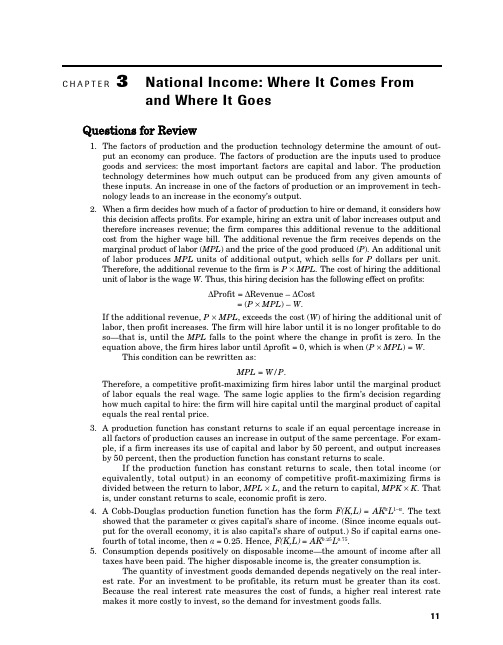
3
National Income: Where It Comes From and Where It Goes
Questions for Review
1. The factors of production and the production technology determine the amount of output an economy can produce. The factors of production are the inputs used to produce goods and services: the most important factors are capital and labor. The production technology determines how much output can be produced from any given amounts of these inputs. An increase in one of the factors of production or an improvement in technology leads to an increase in the economy’s output. 2. When a firm decides how much of a factor of production to hire or demand, it considers how this decision affects profits. For example, hiring an extra unit of labor increases output and therefore increases revenue; the firm compares this additional revenue to the additional cost from the higher wage bill. The additional revenue the firm receives depends on the marginal product of labor (MPL) and the price of the good produced (P). An additional unit of labor produces MPL units of additional output, which sells for P dollars per unit. Therefore, the additional revenue to the firm is P × MPL. The cost of hiring the additional unit of labor is the wage W. Thus, this hiring decision has the following effect on profits: ∆Profit = ∆Revenue – ∆Cost = (P × MPL) – W. If the additional revenue, P × MPL, exceeds the cost (W) of hiring the additional unit of labor, then profit increases. The firm will hire labor until it is no longer profitable to do so—that is, until the MPL falls to the point where the change in profit is zero. In the equation above, the firm hires labor until ∆profit = 0, which is when (P × MPL) = W. This condition can be rewritten as: MPL = W/P. Therefore, a competitive profit-maximizing firm hires labor until the marginal product of labor equals the real wage. The same logic applies to the firm’s decision regarding how much capital to hire: the firm will hire capital until the marginal product of capital equals the real rental price. 3. A production function has constant returns to scale if an equal percentage increase in all factors of production causes an increase in output of the same percentage. For example, if a firm increases its use of capital and labor by 50 percent, and output increases by 50 percent, then the production function has constant returns to scale. If the production function has constant returns to scale, then total income (or equivalently, total output) in an economy of competitive profit-maximizing firms is divided between the return to labor, MPL × L, and the return to capital, MPK × K. That is, under constant returns to scale, economic profit is zero. 4. A Cobb-Douglas production function function has the form F(K,L) = AKαL1–α. The text showed that the parameter α gives capital’s share of income. (Since income equals output for the overall economy, it is also capital’s share of output.) So if capital earns onefourth of total income, then a = 0.25. Hence, F(K,L) = AK0.25L0.75. 5. Consumption depends positively on disposable income—the amount of income after all taxes have been paid. The higher disposable income is, the greater consumption is. The quantity of investment goods demanded depends negatively on the real interest rate. For an investment to be profitable, its return must be greater than its cost. Because the real interest rate measures the cost of funds, a higher real interest rate makes it more costly to invest, so the demand for investment goods falls. 11
(完整版)曼昆宏观经济学原理答案
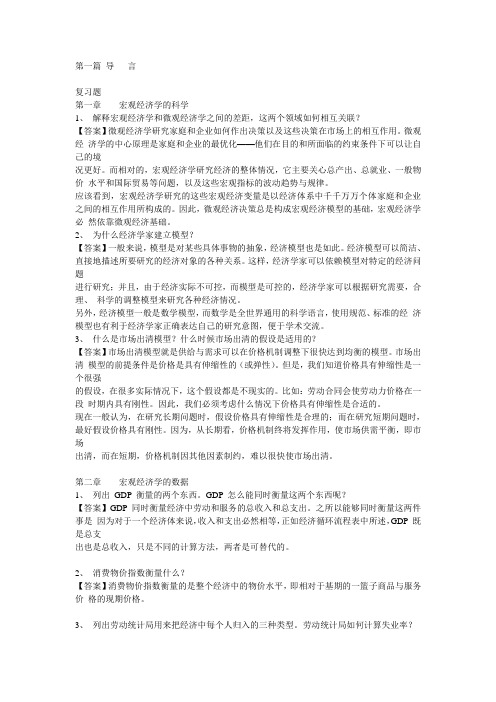
第一篇导言复习题第一章宏观经济学的科学1、解释宏观经济学和微观经济学之间的差距,这两个领域如何相互关联?【答案】微观经济学研究家庭和企业如何作出决策以及这些决策在市场上的相互作用。
微观经济学的中心原理是家庭和企业的最优化——他们在目的和所面临的约束条件下可以让自己的境况更好。
而相对的,宏观经济学研究经济的整体情况,它主要关心总产出、总就业、一般物价水平和国际贸易等问题,以及这些宏观指标的波动趋势与规律。
应该看到,宏观经济学研究的这些宏观经济变量是以经济体系中千千万万个体家庭和企业之间的相互作用所构成的。
因此,微观经济决策总是构成宏观经济模型的基础,宏观经济学必然依靠微观经济基础。
2、为什么经济学家建立模型?【答案】一般来说,模型是对某些具体事物的抽象,经济模型也是如此。
经济模型可以简洁、直接地描述所要研究的经济对象的各种关系。
这样,经济学家可以依赖模型对特定的经济问题进行研究;并且,由于经济实际不可控,而模型是可控的,经济学家可以根据研究需要,合理、科学的调整模型来研究各种经济情况。
另外,经济模型一般是数学模型,而数学是全世界通用的科学语言,使用规范、标准的经济模型也有利于经济学家正确表达自己的研究意图,便于学术交流。
3、什么是市场出清模型?什么时候市场出清的假设是适用的?【答案】市场出清模型就是供给与需求可以在价格机制调整下很快达到均衡的模型。
市场出清模型的前提条件是价格是具有伸缩性的(或弹性)。
但是,我们知道价格具有伸缩性是一个很强的假设,在很多实际情况下,这个假设都是不现实的。
比如:劳动合同会使劳动力价格在一段时期内具有刚性。
因此,我们必须考虑什么情况下价格具有伸缩性是合适的。
现在一般认为,在研究长期问题时,假设价格具有伸缩性是合理的;而在研究短期问题时,最好假设价格具有刚性。
因为,从长期看,价格机制终将发挥作用,使市场供需平衡,即市场出清,而在短期,价格机制因其他因素制约,难以很快使市场出清。
中文曼昆宏观经济学第七版讲义
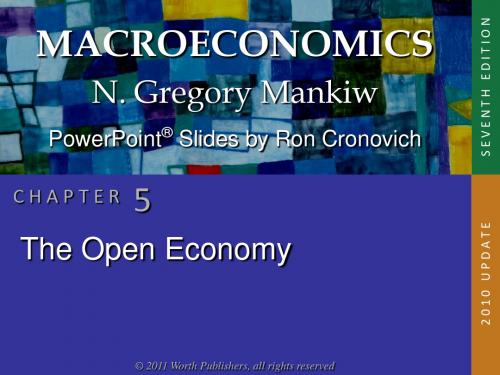
MACROECONOMICS
N. Gregory Mankiw
PowerPoint® Slides by Ron Cronovich
5 C H A P T E R
The Open Economy
© 2011 Worth Publishers, all rights reserved
r
Investment is still a
downward-sloping function
of the interest rate,
but the exogenous
world interest rate…
r*
…determines the
country’s level of
I (r ) investment.
-4%
(right scale)
-4%
-6%
1965 1970 1975 1980 1985 1990 2019 2000 2019 2019
2. Fiscal policy abroad
r
Expansionary
al policy
abroad raises
r
* 2
the world interest rate.
13
Assumptions about capital flows
a. domestic & foreign bonds are perfect substitutes (same risk, maturity, etc.)
b. perfect capital mobility: no restrictions on international trade in assets
曼昆哈佛大学经济学原理第三章共42页

(b) How Trade Increases The Rancher’s Consumption
Rancher’s
B*
consumption
with trade
B
Rancher’s
consumption
without trade
0
2.5 3
5
Harcourt, Inc. items and derived items copyright © 2001 by Harcourt, Inc.
40 lbs.
5 lbs.
Harcourt, Inc. items and derived items copyright © 2001 by Harcourt, Inc.
Self-Sufficiency
By ignoring each other:
Each consumes what they each produce. The production possibilities frontier is also the
Farmer Rancher
Hours Needed to Make 1 lb. of:
Meat
Potatoes
20 hours/lb
10 hours/lb
1 hours/lb
8 hours/lb.
Amount Produced in 40 Hours
Meat
Potatoes
2 lbs.
4 lbs.
consumption possibilities frontier.
Without trade, economic gains are diminished.
Harcourt, Inc. items and derived items copyright © 2001 by Harcourt, Inc.
中文曼昆宏观经济学第七版讲义

S
model to
determine
r*
the impact of
an increase in investment
NX1
demand on
NX, S, I, and
net capital
outflow.
I1
I (r )1
S, I
ANSWERS:
3. An increase in investment demand
13
Assumptions about capital flows
a. domestic & foreign bonds are perfect substitutes (same risk, maturity, etc.)
b. perfect capital mobility: no restrictions on international trade in assets
12
National saving: The supply of loanable funds
r
SYC(YT)G
As in Chapter 3, national saving does
not depend on the interest rate
S
S, I
CHAPTER 5 The Open Economy
= net outflow of “loanable funds” = net purchases of foreign assets
the country’s purchases of foreign assets minus foreign purchases of domestic assets
经济学原理 曼昆第三章
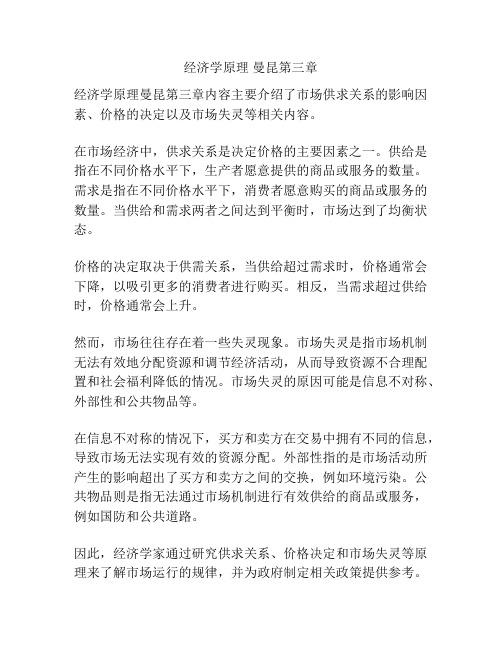
经济学原理曼昆第三章
经济学原理曼昆第三章内容主要介绍了市场供求关系的影响因素、价格的决定以及市场失灵等相关内容。
在市场经济中,供求关系是决定价格的主要因素之一。
供给是指在不同价格水平下,生产者愿意提供的商品或服务的数量。
需求是指在不同价格水平下,消费者愿意购买的商品或服务的数量。
当供给和需求两者之间达到平衡时,市场达到了均衡状态。
价格的决定取决于供需关系,当供给超过需求时,价格通常会下降,以吸引更多的消费者进行购买。
相反,当需求超过供给时,价格通常会上升。
然而,市场往往存在着一些失灵现象。
市场失灵是指市场机制无法有效地分配资源和调节经济活动,从而导致资源不合理配置和社会福利降低的情况。
市场失灵的原因可能是信息不对称、外部性和公共物品等。
在信息不对称的情况下,买方和卖方在交易中拥有不同的信息,导致市场无法实现有效的资源分配。
外部性指的是市场活动所产生的影响超出了买方和卖方之间的交换,例如环境污染。
公共物品则是指无法通过市场机制进行有效供给的商品或服务,例如国防和公共道路。
因此,经济学家通过研究供求关系、价格决定和市场失灵等原理来了解市场运行的规律,并为政府制定相关政策提供参考。
宏经第三章(曼昆)
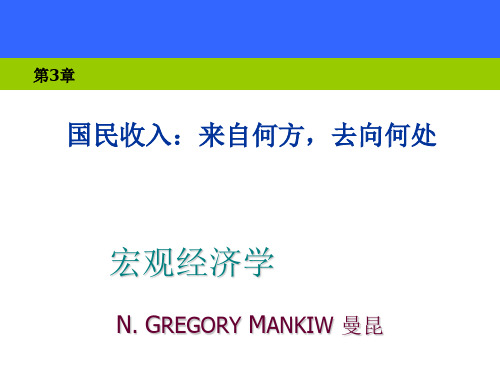
F (zK , zL) =
=
=
z K+ z L
z
(
K+ L
)
decreasing returns to scale for any z > 1
=
z F (K , L)
slide 7
例3
F (K , L) = K 2 + L2 F (zK , zL) = (zK )2 + (zL)2 = z 2 ( K 2 + L2 )
以MPL为纵轴, 为纵轴, L 为横轴
L 0 1 2 3 4 5 6 7 8 9 10
Y 0 10 19 27 34 40 45 49 52 54 55
MPL n.a. ? ? 8 ? ? ? ? ? ? ?
slide 19
Answers:
MPL (units of output)
Production function Output (Y)
G =G
and
T =T
slide 40
产品和劳务市场
总需求 总供给
C ( − T ) + I (r ) + G Y
Y = F (K , L )
Y = C ( − T ) + I (r ) + G Y
均衡
实际利率调整使需求等于供给
slide 41
可贷资金市场
金融系统中简单的供求模型 一种资产:可贷资金 资金需求:投资 investment 资金供给:储蓄 saving 资金价格: 实际利率 real interest rate
2 2
K2 = z L = z F (K , L)
constant returns to scale for any z > 0
第七版曼昆宏观经济学课件-PPT
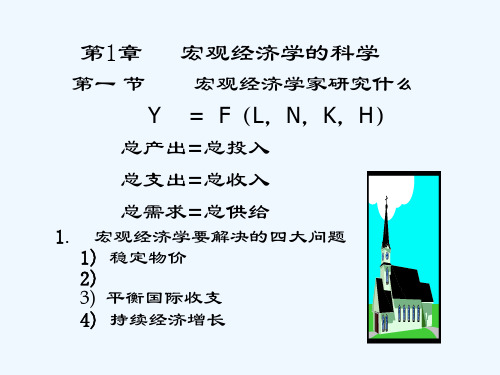
a 0 -a
MPS>APS
S=f(Y)
Y
C曲线上某点的射线的斜率为APC C曲线上某点的切线的斜率为MPC S曲线上某点的射线的斜率为APS S曲线上某点的切线的斜率为MPS
MPC<APC
三. 进口需求
IM = m+γY m是自发性进口,γ为国民收入的边际进口倾向。
γ=ΔIM/ΔY 四. 投资,政府购买和出口的需求
通过核算在一定时期内整个社会购买最终产 品的总支出即最终产品的总卖价来计量GDP的。
GDP=C+I+G+(EX-IM)
国民收入=消费支出+投资支出+政府购买支出+净出口支出
2.收入法( Income Approach) 即用要素收入亦即企业生产成本核算GDP。 国民总收入=工资+利息+利润+租金 +间接税和企业的转移支付+折旧
I+G+NX = S+T
(NX为净出口,T为净税收.)
I = S +(T-G)+(IM-EX)
4. 漏出和注入
1)漏出指居民或企业的收入中作为储蓄、 税收和进口等而没有支付给对方的那部分。
2)注入指居民或企业得到的收入中,不 是相互由对方付给的那部分。如投资、出 口、政府支出等。
W=J
S + TA + IM + = I + G +EX +TR
1. 物品的供求 1) 物品的供给与生产函数 Y = F ( K, L ) Y/L = F (K/L, L/L ) = F ( K/L, 1 )
y=f(k)
y
y=f(k)
MPK = f(k+1)-f(k)
中文曼昆宏观经济学第七版讲义
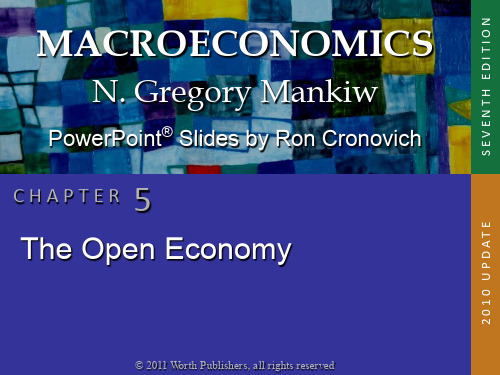
r 1*
NX2 S 1 NX1
Results:
I 0
N X I0
I
(
r
* 2
)
CHAPTER 5 The Open Economy
I
(
r
* 1
)
I (r )
S, I
21
NOW YOU TRY:
3. An increase in investment demand
r
Use the
2010 UPDATE
In this chapter, you will learn:
accounting identities for the open economy
the small open economy model
what makes it “small” how the trade balance and exchange rate
capital outflow
and net exports
CHAPTER 5 The Open Economy
S NX
I (r )
I1
S, I
17
Next, three experiments:
1. Fiscal policy at home 2. Fiscal policy abroad 3. An increase in investment demand
9
Saving, investment, and the trade balance
(percent of GDP) 1960-2019
investment
saving
trade balance (right scale)
宏观经济学曼昆第七版第3章(2013,修正后)

经济学院经济系
戴天仕2013
3.2 国民收入如何分配给生产要素
本问题的答案:
国民收入的分配由要素价格决定,而要素价格 取决于要素的边际产出。 注:企业为了获得生产要素必须支付租金,而 家庭通过出让生产要素获得报酬。因此,拥有的生 产要素数量和生产要素的价格决定了家庭的收入水 平。本小结只分析产出在要素之间的分配,但我们 知道背后是产出在一个个家庭中的分配。
在劳动投入不变的情况下,增加一单位资本所得 到的额外产量。
14
经济学院经济系
戴天仕2013
企业增加一单位资本的收益 P × MPK 企业增加一单位资本的成本 R 在最优状态时,增加一单位资本的收益应 该等于成本: P × MPK = R
注:与劳动需求的分析基本一样。
经济学院经济系
15
戴天仕2013
人们为什么要购买生产出来的东西?
本节分别从以下角度回答这一问题:
消费(C) 投资(I) 政府购买(G)
Y = C + I + G
注:为了简化分析,我们暂时不考虑净出口。 因此,我们说本章分析的是封闭经济。
经济学院经济系
29
戴天仕2013
消费
家庭如何决定消费多少?
一般认为私人消费取决于税后收入,即可支配收 入。可用下式表达
34
经济学院经济系
戴天仕2013
为简化分析过程,本章将投资收益率视为外生 给定,假设投资需求只取决于利率。
I = I (r )
其中,I是投资,I( )是一个减函数,r是实际利 率,即名义利率经通货膨胀调整后的利率。
为了简化下文的叙述,我们定义两个变量
实际工资:W/P 资本的实际租赁价格:R/P 根据上文分析,有:
- 1、下载文档前请自行甄别文档内容的完整性,平台不提供额外的编辑、内容补充、找答案等附加服务。
- 2、"仅部分预览"的文档,不可在线预览部分如存在完整性等问题,可反馈申请退款(可完整预览的文档不适用该条件!)。
- 3、如文档侵犯您的权益,请联系客服反馈,我们会尽快为您处理(人工客服工作时间:9:00-18:30)。
中国 新加坡 印度 日本 西班牙 以色列 哥伦比亚 美国 加拿大 菲律宾 卢旺达 新西兰 阿根廷 沙特阿拉伯 乍得
人均GDP: 2011
$8,442 $61,103 $3,650 $34,278 $32,701 $28,007 $10,103 $48,442 $40,541 $4,140 $1,251 $30,108 $17,674 $24,434 $1,531
,那么生产率会更高 就是说:K/L的增加导致Y/L的增加
*
生产率是如何决定的
2.人均人力资本
人力资本 (H): 工人通过教育、培训和经验而获得的知识与技 能
H/L =普通工人的人力资本 如果普通工人有更多的人力资本(知识、技能
等),那生产率会更高 就是说:H/L的增加会导致Y/L的增加
*
*
你认为下述哪种政策能够在长期内有效地促进不发达
国家的经济增长和生活水平的提高?
a.对本地企业提供投资的税收激励
b.
给经常去上课的学生发现金
c.打击政府腐败
d.
限制进口来保护国内产业
e.允许自由贸易
接下来我们转向公共政策,看看哪 些政策可以促进生产率的长期增长
和提高生活水平
*
1.储蓄和投资
▪ 我们可以通过投资来增加资本,以提高生产率 ▪ 因为资源是稀缺的,把更多资源用于生产资本就
要求把较少资源用于生产现期消费的物品与劳务 ▪ 降低消费 = 增加储蓄
增加的储蓄向投资物品的生产提供资金 (下章将更详细地考察具体细节) ▪ 因此,当期与未来的消费之间存在一种权衡取舍
N. 格里高利·曼昆
经济学原理
第七版
3
生产与增长
本章探索的主要问题:
• 世界各国生活水平和经济增长率处于什么样的状
况?
• 为什么生产率对于生活水平如此重要? • 什么决定生产率及其增长? • 公共政策怎样影响经济增长和生活水平?
*
一个英国普通家庭及其所有财产,发达国家
人均GDP: 预期寿命:
$36,130 80 years
问题: ▪ 为什么一些国家比另一些国家要富裕? ▪ 为什么一些国家经济快速增长而另一些国家则处
于贫穷陷阱之中? ▪ 怎样的政策能够帮助提高经济增长率和长期生活
水平?
*
一、生产率
*
生产率是如何决定的
1.人均物质资本
复习:用于生产物品和劳务的设备和建筑物存 量称为[物质]资本,用K表示
K/L = 人均资本 如果普通工人有更多的资本(机器,设备等)
经济增长率: 1970–2011年
7.5% 4.8% 3.3% 2.1% 2.0% 2.1% 2.0% 1.8% 1.7% 1.3% 1.2% 1.2% 1.4% 0.6% 0* .7%
世界各国的收 入与经济增长
事实 2: 世界各国 的经济增 长率有很 大差别
中国 新加坡 印度 日本 西班牙 以色列 哥伦比亚 美国 加拿大 菲律宾 卢旺达 新西兰 阿根廷 沙特阿拉L, K, H, N)
生产函数有规模收益不变的特征:所有投入数 量增加相同比例,产出也会增加那个相同的比 例。例如:
所有投入数量翻一番(每种投入数量乘以2) 会使产出也翻一番:
2Y = A F(2L, 2K, 2H, 2N)
▪ 所有投入数量增加10% (每种投入数量乘以1.1) 会
世界各国的收入与经济增长
由于经济增长率不同,各国的收入排名随时间而不 断变化: ▪ 发展中国家并不注定永远贫穷–比如,新加坡的
收入在1960年时很低,但现在却相当高 ▪ 发达国家并不能保证它们将来也是“发达国家”
:它们可能被一些目前不如它们富裕,但经济快 速增长的国家所超过
*
世界各国的收入与经济增长
生产率是如何决定的
3.人均自然资源
▪ 自然资源 (N):由自然界提供的用于生产物品与
劳务的投入,如 土地、河流和矿藏
▪ 其他条件相同的情况下,一个国家有更多的N便 可以生产出更多的Y N/L的增加会导致Y/L的增加
▪ 一些国家很富裕是因为它们拥有丰富的自然资源 (比如沙特阿拉伯有大量的石油)
▪ 但国家并不需要有大量的自然资源才能使自己富 裕 (比如日本进口它所需的自然资源)
▪ 人力资本源于人们为获得这种知识所做的努力 ▪ 两者对于生产率都很重要
*
参考资料
生产函数是描述投入量与产出量之间关系的图 表或等式: Y = A F(L, K, H, N)
F( ) –是一个表示投入如何结合起来以生产产出的 函数 “A” – 技术水平
“A”乘以F( ),因此技术进步( “A”的增 加)会使经济可以用既定的投入组合生产出更 多产量(Y)
使产出也增加10%: 1.1Y = A F(1.1L, 1.1K, 1.1H, 1.1N)
*
生产函数
Y = A F(L, K, H, N)
如果我们把每种投入都乘以1/L,那产出也会 乘以 1/L: Y/L = A F(1, K/L, H/L, N/L)
这个等式表示生产率(人均产出)取决于:
技术水平(A) 人均物质资本 人均人力资本 人均自然资源
*
生产率是如何决定的
4.技术知识
▪ 技术知识:社会对生产物品与劳务的最好方法的 了解。
▪ 技术进步并不仅仅意味着更快的计算机,更清晰 的电视,或者更小的手机
▪ 它意味着能提高生产率的一切高级知识(使社会从 已有的资源中得到更多的产出) ▪ 比如亨利·福特和生产线
▪ 技术知识与人力资本:技术知识是指社会对如何生产物品 和劳务的理解
人均GDP: 2011
$8,442 $61,103 $3,650 $34,278 $32,701 $28,007 $10,103 $48,442 $40,541 $4,140 $1,251 $30,108 $17,674 $24,434 $1,531
经济增长率: 1970–2011年
7.5% 4.8% 3.3% 2.1% 2.0% 2.1% 2.0% 1.8% 1.7% 1.3% 1.2% 1.2% 1.4% 0.6% 0* .7%
一个墨西哥普通家庭及其所有财产,中等收入国家
人均GDP: 预期寿命: 成人识字率:
$14,270 76 years 86%
一个马里普通家庭及其所有财产,发展中国家
人均GDP: 预期寿命: 成人识字率:
$1,090 52 years 46%
世界各国的收 入与经济增长
事实1: 世界各国 的生活水 平有着巨 大差别
